Annual Maintenance Repair and Operations (MRO) Survey 2018: Spending on the rise
New industry survey shows that 94% of companies view MRO as an important part of their overall operations.

As the machine that keeps the world’s plants, factories and other business facilities up and running, MRO (maintenance, repair and operations) represents a broad range (and hundreds of sub-categories) of products. But in today’s world, MRO isn’t just about making sure you have the right parts on hand; it’s also about managing those assets in a way that positively impacts business performance and ensures as little operational downtime as possible.
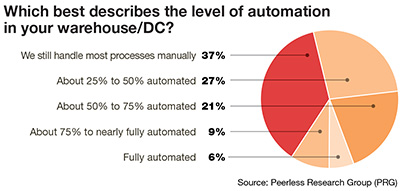
This year’s Peerless Research Group (PRG) MRO study reveals a business environment where MRO continues to play an important role in all of those activities, and more. With the largest group of respondents (14%) saying their maintenance directors, managers or supervisors serve as the MRO “champions” at their companies (followed by plant managers [9%] and engineering [9%]), the most common job titles/functions handling these decisions include director/manager of maintenance (34%), VP/director/manager of operations (17%), and VP/director/manager of procurement and sourcing (17%). In all, roughly 50% of the titles and functions pin-pointed during the survey operate at the managerial level.
For 20% of these professionals, MRO management is a main responsibility for which they are the primary decision makers, while 48% consider it “one of my responsibilities.” And, 29% have input on MRO-related decisions.
MRO spending on the rise
In 2017, 42% of respondents spent less than $1 million on MRO products and services, which encompass spare parts and consumables. Sixteen percent spent between $1 million and $4.9 million on MRO, while another 12% allocated $5 million to $9.9 million for the parts and supplies that keep their plants and factories running. In addition, 43% of supply chain professionals surveyed said they spend less than 3% of their overall supply chain budget on MRO maintenance, while 27% spend 3% to 5%.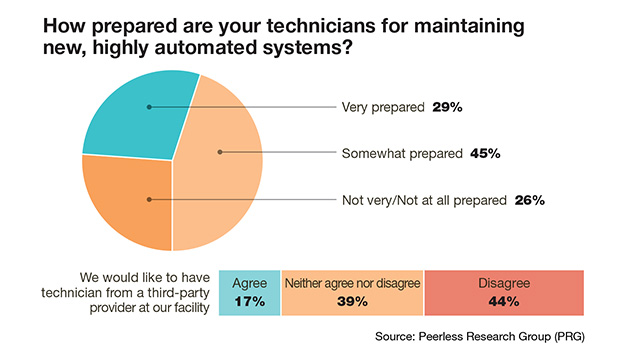
When asked how this level of spending compares with their total spend on MRO products and services in 2016, 68% said they spent about the same, 22% said they spent more, and 10% said they spent less. In 2018, 25% of respondents expect to spend more on MRO products and services than they did in 2017, while 69% will maintain their current spending levels and 6% will spend less this year.
For most companies (63%), MRO solution-related information comes directly from manufacturers and their Web sites. Another 58% rely on distributors and their Web sites for this information, while 56% turn to materials handling publications.
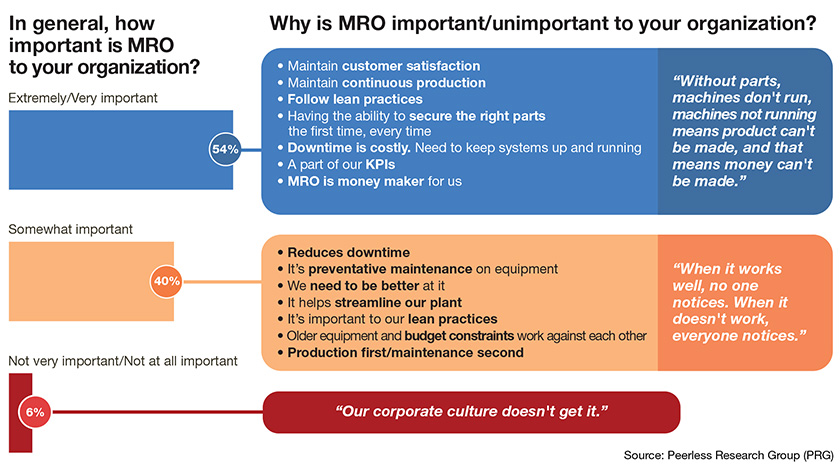
The critical nature of MRO
For 94% of respondents, MRO is either extremely or somewhat important to their companies’ overall operations. Only 6% indicated that MRO was not very important or not at all important.
Those who see MRO as “extremely” important say it helps their firms maintain customer satisfaction, maintain continuous production, follow lean practices, and secure the “right parts for the first time, every time.” Respondents that view MRO as “somewhat important,” say it helps to reduce downtime, manage preventative maintenance and streamline their plants. “Without parts, machines don’t run, machines not running means product can’t be made,” one survey respondent said, “which means money can’t be made as well.”
More than half (52%) of the companies surveyed are using a hybrid MRO management model, which means they handle some maintenance tasks internally and outsource others. Forty-four percent say internal staff solely manages MRO and only 4% completely outsource their MRO management. Asked about the benefits of managing MRO internally, 61% of respondents say it’s the ability to control MRO solutions inventory while 57% see it as a less costly approach (versus outsourcing).
As for the benefits of using a third-party maintenance provider or OEM for MRO management, 58% say it allows them to “focus on our core business/functions.” Thirty-seven percent said not having to hold an excess of on-hand parts or consumables inventory was the biggest benefit, while 36% like the fact that outsourcing enables improvements in labor productivity.
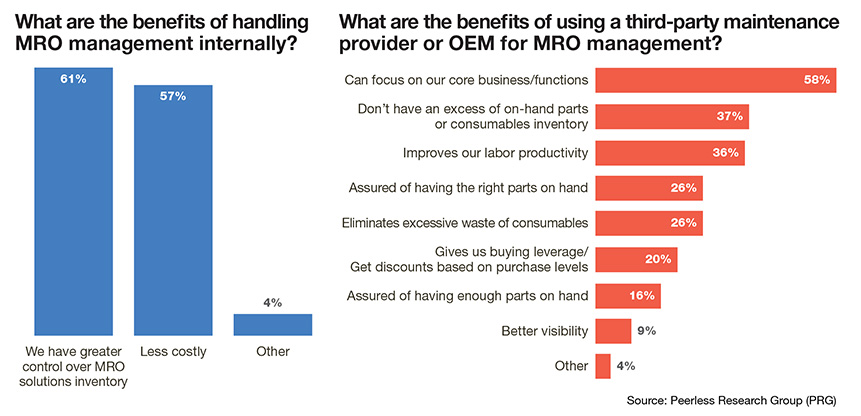
A slow push toward automation
As warehouse automation continues to proliferate, the percentage of companies adopting these solutions is rising exponentially—albeit slowly. When asked about the level of automation in their warehouse/DC, 37% of respondents said they still handle most processes manually and 27% say their warehouse is about 25% to 50% automated.
For 21% of respondents, warehouse operations are “50% to 75% automated” while just 6% are using fully automated distribution facilities. In terms of preparing their technicians for maintaining new, highly automated systems, 45% said “somewhat prepared” and 29% said “very prepared.” Another 26% said their techs are “not very/not prepared at all.”
Automated systems maintenance continues to raise challenges for operations managers, with 27% agreeing that automated materials handling systems are becoming harder to maintain (58% are neutral and 15% disagree with that statement). The top three equipment failures, breakdowns or repairs that occur most often are power generators/motors, drives, gears (38%), sensors (36%) and conveyor rollers (34%).
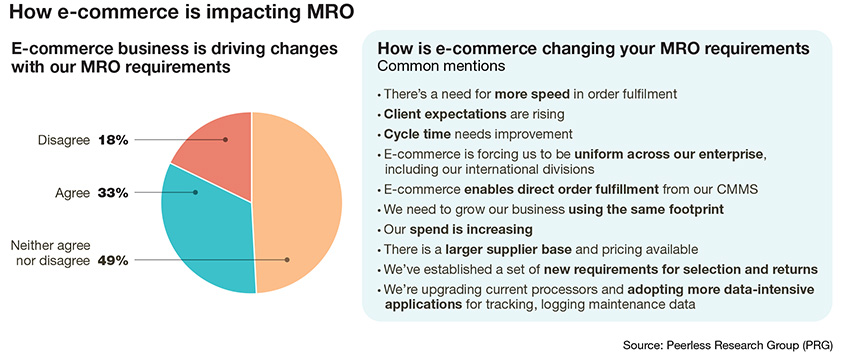
Thirty-seven percent of respondents say they have a difficult time finding the technical skills needed to maintain their systems, thus revealing a true knowledge gap for technicians who are being asked to manage this state-of-the-art machinery and equipment.
E-commerce as a key driver
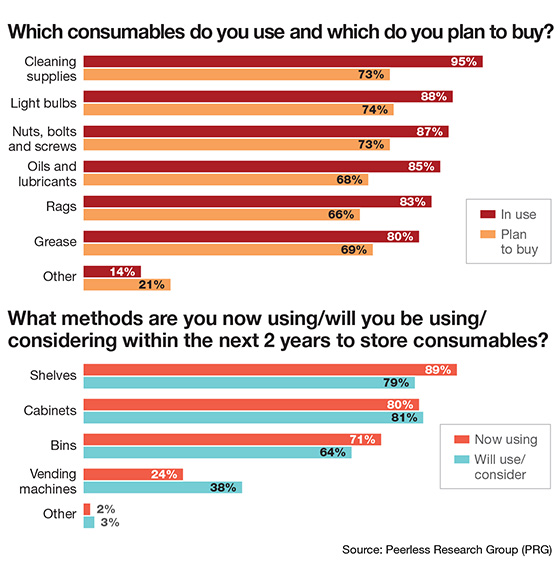 The evolution of e-commerce is impacting MRO requirements more and more each year. In fact, survey respondents say e-commerce has affected their companies in many ways, such as the need for speedier order fulfillment, better accommodation of rising client expectations, increase in spending, improved cycle times, and the need to maintain uniform processes across the enterprise (including international divisions). Asked whether e-commerce is driving changes with their MRO requirements, 33% say it is while 18% say it’s not (49% neither agree nor disagree).
The evolution of e-commerce is impacting MRO requirements more and more each year. In fact, survey respondents say e-commerce has affected their companies in many ways, such as the need for speedier order fulfillment, better accommodation of rising client expectations, increase in spending, improved cycle times, and the need to maintain uniform processes across the enterprise (including international divisions). Asked whether e-commerce is driving changes with their MRO requirements, 33% say it is while 18% say it’s not (49% neither agree nor disagree).
Pin-pointing the MRO products currently in use at their companies, 74% use safety equipment (i.e., gloves, goggles, work shoes and ear plugs), 69% point to maintenance and cleaning supplies, 64% are using forklift repair services, and 58% use spare parts and components (i.e., motors, conveyor rollers, and gears). Other key MRO products include maintenance equipment, including floor sweepers and tools (49%); third-party maintenance services for automated equipment (34%); and third-party monitoring of automated equipment, lift trucks, motors and/or automatic data collection devices (26%).
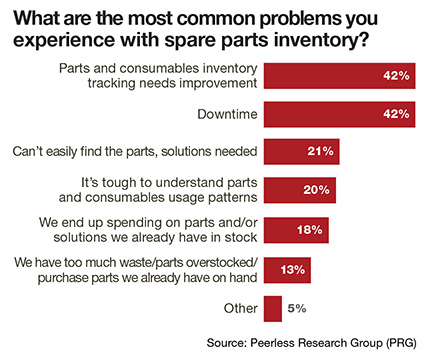 A critical component of any firm’s MRO inventory, spare parts management is creating numerous challenges for the companies that maintain it. When asked about the problems related to spare parts inventory, 42% of respondents said their parts and consumables inventory tracking needed improvement, while another 42% claimed downtime was their biggest spare parts issue. Other responses included difficulty finding the parts or solutions needed (21%), and having a tough time understanding parts and consumables usage patterns (20%). Eighteen percent of respondents say they end up spending money on parts and/or solutions they already have in stock, and 13% say they have too much waste and overstock.
A critical component of any firm’s MRO inventory, spare parts management is creating numerous challenges for the companies that maintain it. When asked about the problems related to spare parts inventory, 42% of respondents said their parts and consumables inventory tracking needed improvement, while another 42% claimed downtime was their biggest spare parts issue. Other responses included difficulty finding the parts or solutions needed (21%), and having a tough time understanding parts and consumables usage patterns (20%). Eighteen percent of respondents say they end up spending money on parts and/or solutions they already have in stock, and 13% say they have too much waste and overstock.
Currently, 70% of respondents say they obtain parts from a distributor; 65% say they access spare parts from an OEM; and 59% are using systems suppliers. Forty-five percent of companies are using a computerized maintenance management system (CMMS) for their equipment, while 18% are considering or evaluating condition-monitoring software. And, 17% say they don’t know enough about CMMS to use it, and 20% are not considering such a system at this time.
When it comes to CMMS, 44% say they use a Cloud-based application, while 35% are not currently using CMMS in the Cloud but are willing to consider it in the future. In all, 61% of respondents said their MRO management for their automated systems was efficient. And, 17% feel their processes are highly efficient while another 22% said their MRO management is inefficient.
The all-important consumables
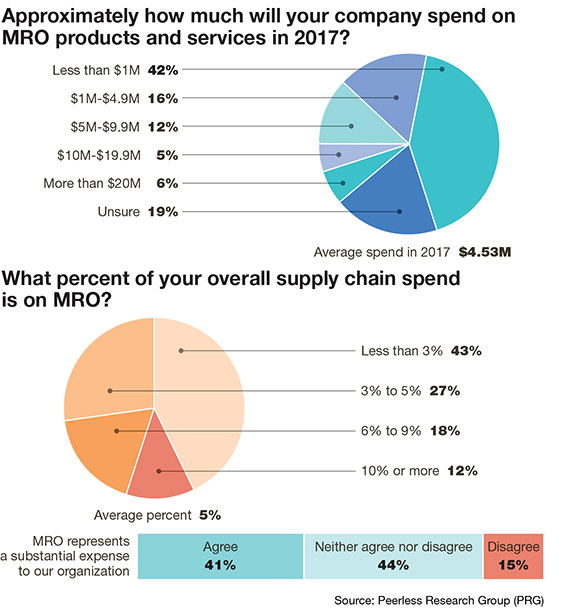 As the supplies that are exhausted during operation and maintenance, consumables play an important role in the manufacturing process and, as such, are a top-of-mind issue for anyone involved in MRO procurement. According to the survey, the most popular consumables right now include cleaning supplies (for 95% of respondents); light bulbs (88%); nuts, bolts and screws (87%); and oils and lubricants (85%). To store their consumables, companies typically use shelves (89%), cabinets (80%), bins (71%) and vending machines (24%). Within the next two years, 38% of firms plan to explore the use of vending machines for their MRO consumables.
As the supplies that are exhausted during operation and maintenance, consumables play an important role in the manufacturing process and, as such, are a top-of-mind issue for anyone involved in MRO procurement. According to the survey, the most popular consumables right now include cleaning supplies (for 95% of respondents); light bulbs (88%); nuts, bolts and screws (87%); and oils and lubricants (85%). To store their consumables, companies typically use shelves (89%), cabinets (80%), bins (71%) and vending machines (24%). Within the next two years, 38% of firms plan to explore the use of vending machines for their MRO consumables.
In rating their companies’ ability to locate consumables when they are needed, 26% of respondents say it’s “excellent,” and they have several go-to vendors to work with. Forty-nine percent consider their consumable storage approach to be “very good,” while 21% say they’re fairly organized in this area. “We have an automated system that orders all consumables and parts straight from suppliers as they are used,” one respondent says, “and keeps our inventory at a level that allows us to not worry about any maintenance issues.”
About the MRO Survey
This research was conducted by Peerless Research Group (PRG) on behalf of Materials Handling MRO and Modern Materials Handling magazines to assess the purchase decision process, utilization and practices regarding maintenance, repair and operations (MRO) products and services for warehouses and distribution centers.
Distributed by e-mail in November 2017, the survey yielded 161 usable responses across a range of job titles, all of whom are personally involved in the maintenance of automated systems and the purchase process for MRO solutions for their companies, which range in value from less than $50 million (37%) to $2.5 billion or more (11%).
The bulk of respondents (56%) work for manufacturing firms, while 12% (respectively) are employed at either wholesale trade or retail trade organizations. The average margin of error for the study was ±8.8% at the 95% confidence level.

Article Topics
Latest in Logistics
LM Podcast Series: Assessing the freight transportation and logistics markets with Tom Nightingale, AFS Logistics Investor expectations continue to influence supply chain decision-making The Next Big Steps in Supply Chain Digitalization Under-21 driver pilot program a bust with fleets as FMCSA seeks changes Diesel back over $4 a gallon; Mideast tensions, other worries cited Four U.S. railroads file challenges against FRA’s two-person crew mandate, says report XPO opens up three new services acquired through auction of Yellow’s properties and assets More LogisticsAbout the Author
Subscribe to Logistics Management Magazine

Find out what the world's most innovative companies are doing to improve productivity in their plants and distribution centers.
Start your FREE subscription today.
April 2023 Logistics Management

Latest Resources














